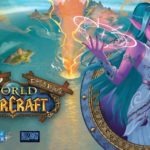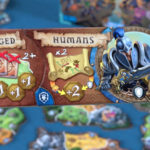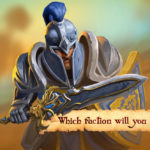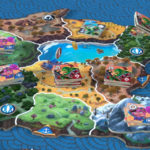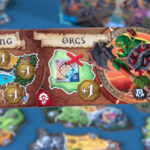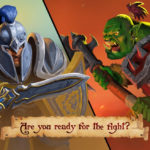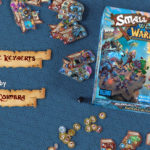
One of the interesting things about this job is that I am pretty regularly presented with a new set of things to review and try out that I never would have expected before it became a thing. Seriously, the number of board games I would have expected to review had long sat at a nice round zero, and then Small World of Warcraft was a thing that happened. So here I am with a playtest copy of the game (though a bit later than planned), which by my count is not even the first World of Warcraft board game we’ve gotten.
But SWoW (which will be the acronym used from here on out, because it amuses me) is not really aiming to be a simulation of the MMORPG itself; it’s more meant to create the feel of the world of Azeroth. It is, in many ways, a reskinning of the original game Small World with a few extra rules, another variant to help you make the game feel more like WoW, and a lot of different artwork. That means any review has to both ask whether or not the game itself works and whether or not the allusions to WoW are actually a net positive. Fortunately… yeah, it really does.
The principles behind SWoW are very simple. This world ain’t big enough for the two of you, where “the two of you” means anywhere from two to five players and “this world” means “the collection of islands you pick out from the beginning.” Yes, the irony of the game taking place on islands is not lost upon me, but the point remains that you have your island spaces and your goal is to take as much territory as you can, earning victory points and ultimately seeing who gets the most after a set number of turns.
You start by letting both players select a combination of a race and a special power. Every race has certain inherent effects; for example, Gnomes can launch aerial assaults of zones once per turn, while Orcs get more victory points for conquering Alliance regions and Night Elves can take Forest regions much more easily. The special powers, meanwhile, also fill in some extra abilities and cane be mixed and matched with the main race. Portal Mages can easily transport things from one zone to another if there’s enough magic. Mountaineers get more points for holding mountain zones. Sailors traverse water easily. You get the idea.
From there… well, you want to conquer as much as you can. Each race and power comes with a certain number of race tokens, and you spend those tokens to take over zones. Combat is handled as an additional cost, which helps keep things quick. If you want to take a zone with three Orc tokens while you’re playing as Draenei, for example, you’ll need to pay five tokens to take the region, but there’s no rolling to complicate things… although you’d better hope there’s something worth all that effort within the zone.
The main balancing mechanism in play here is that aside from spending tokens to take zones, you need to have one in each zone you control. So if you have a pool of 10 Draenei, to use that earlier example, and you control six zones… well, you have four tokens to take other zones. That’s a pretty small number.
In order to keep things moving, you can thus choose to place your active race and power in decline, which lets you pick out a new race and retain the control of zones you previously had but prevents you from placing any further tokens for the race in decline. This is, as with other things, a strategic choice; it means ending your turn early, but it can allow greater expansion moving forward. Especially if, say, one of your races is Naga and thus occupies space that otherwise cannot be conquered.
All of this sounds a bit more complicated than it is. In practice, the game moves at a fairly solid clip, and if anything my wife and I found ourselves occasionally confused not because the game was complicated but because we expected it to be complicated. In every respect, the game aims to be light and fast-moving. Even the added bits of complexity like artifacts and places of power are pretty easy to understand.
There are a few grey areas, though. For example, the rules are unclear if entry points on an island under the control of one of your decline races still count as “yours” or if you need to start fresh, and whether you should remove the tokens when moving into that region. None of them were huge problems for my wife and I, but if you’re playing with kids, you should be prepared to make a few quick rulings and stick by them.
I’m also not a huge fan of the randomness involved in selecting a race and powers. Certainly there are probably some combinations that are lightly broken (Ranger Night Elves, for example, can easily take pretty much any forest and get bonus points for holding forests), but getting to pick would be my personal preference. It’s not as if it’s difficult to change the rules for your house, of course; indeed, the “Battle for Azeroth” variant packaged with the game makes it clear how you can opt to change things up to make the game a bit more like WoW if you want to.
And that’s the real nice part of the game as it stands. There’s just enough complexity that the assortment of playable races all have distinct niches and gameplay, from Goblins to Forsaken to Ethereals; at the same time, it’s simple enough that you never find yourself struggling to remember huge chunks of game mechanics. It’s the sort of game that’s easy to sit down and play with kids with minimal guidance, and with strategy that should be easy to grasp but offers lots of interesting play opportunities.
Plus, the added flavor of Azeroth really does improve the game as a whole. It’d be fun even without the skin of these familiar races, but it helps that you’re not just dealing with a generic airborne race but the Gnomes and their flying machines. Or the very specific flavor of Naga taking to the water in ways no other race can. It really does seem that the designers nudged the game’s core rules just a bit to keep things feeling true to the franchise, rather than applying a skin to the rules without a care.
It helps that the art in the game is gorgeous and the tokens are all of a nice, sturdy cardstock that feels it’ll hold up to continued play. It’s not going to stop bullets or anything, but it’s high-quality. Less pleasant is the sheer amount of time you need to punch things out and set everything up, but once you’re actually playing, it all glides along at a steady and reliable clip.
While SWoW doesn’t pretend to be a representation of the MMO in tabletop format, longtime Warcraft and WoW fans will have a lot of fun with this one. If you’re living with other fans or one-time players, this is a great thing to break out for a bit of quick Azerothian conquest. And unlike the aforementioned MMO, this game won’t make you feel as if all the fun stuff gets abandoned once you leave one island or another.
 War never changes, but World of Warcraft does, with a decade of history and a huge footprint in the MMORPG industry. Join Eliot Lefebvre each week for a new installment of WoW Factor as he examines the enormous MMO, how it interacts with the larger world of online gaming, and what’s new in the worlds of Azeroth and Draenor.
War never changes, but World of Warcraft does, with a decade of history and a huge footprint in the MMORPG industry. Join Eliot Lefebvre each week for a new installment of WoW Factor as he examines the enormous MMO, how it interacts with the larger world of online gaming, and what’s new in the worlds of Azeroth and Draenor.

